|
|
|
Sort Order |
|
|
|
Items / Page
|
|
|
|
|
|
|
| Srl | Item |
| 1 |
ID:
169841


|
|
|
|
|
| Summary/Abstract |
Renewable energy development in deregulated electricity markets dominated by fossil fuels has benefited from various government incentives and green marketing. Electricity generation in New Zealand is dominated by renewables and has developed with no government incentives or green marketing since the reforms in 1986. The New Zealand government has set a renewable energy target of 90% by 2025 with no direct support. The objective of this paper is to assess the potential for consumer-driven renewable energy development required to achieve this target by estimating willingness to pay for green electricity in the context of supplier choice. The study is based on a stated choice dataset generated using a choice experiment administered to an online panel of domestic electricity consumers in 2014. Results from a random parameter logit model estimated on 2688 choice responses show that, on average, consumers are willing to pay an extra $3.20 per month or 2% of their current power bills for a 10 percentage point increase in the share of electricity from renewable sources. These findings demonstrate that consumers are willing to support the development of renewables even where a market is dominated by renewables.
|
|
|
|
|
|
|
|
|
|
|
|
|
|
|
|
| 2 |
ID:
143393


|
|
|
|
|
| Summary/Abstract |
A survey was conducted among 1489 consumers in seven pilot cities designated by the Chinese Ministry of Commerce for constructing a meat circulation traceability system.This study set four attributes for pork: traceability information, quality certification, appearance, and price. The preferences and willingness to pay (WTP) of consumers for traceability information, quality certification, appearance attributes, and influencing factors were investigated using choice experiments. According to results from both mixed logit and latent class models, quality certification was the most important characteristic, followed by appearance, and traceability information. “Government certification,” “very fresh-looking,” and “traceability information covering farming, slaughter and processing, circulation and marketing” were the most preferred levels of quality certification, appearance, and traceability information, respectively. Significant heterogeneity was observed in the consumer preferences for these attributes. The preferences and WTP of consumers for traceability information and quality certification were significantly influenced by age, monthly family income, and education level.
|
|
|
|
|
|
|
|
|
|
|
|
|
|
|
|
| 3 |
ID:
105803


|
|
|
|
|
| Publication |
2011.
|
| Summary/Abstract |
Although wind power is currently the most efficient source of renewable energy, the installation of wind turbines (WT) in landscapes often leads to conflicts in the affected communities. We propose that such conflicts can be mitigated by a welfare-optimal spatial allocation of WT in the landscape so that a given energy target is reached at minimum social costs. The energy target is motivated by the fact that wind power production is associated with relatively low CO2 emissions. Social costs comprise energy production costs as well as external costs caused by harmful impacts on humans and biodiversity. We present a modeling approach that combines spatially explicit ecological-economic modeling and choice experiments to determine the welfare-optimal spatial allocation of WT in West Saxony, Germany. The welfare-optimal sites balance production and external costs. Results indicate that in the welfare-optimal allocation the external costs represent about 14% of the total costs (production costs plus external costs). Optimizing wind power production without consideration of the external costs would lead to a very different allocation of WT that would marginally reduce the production costs but strongly increase the external costs and thus lead to substantial welfare losses.
|
|
|
|
|
|
|
|
|
|
|
|
|
|
|
|
| 4 |
ID:
166986
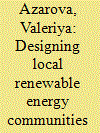

|
|
|
|
|
| Summary/Abstract |
Resistance of the local population to new energy infrastructure may hinder achieving the European Union's goal that 32% of energy consumption come from renewable sources. A vast literature is available on the social acceptance of specific renewable energy technologies, but existing research lacks assessments regarding comprehensive transformations to local energy systems. Moreover, the promising energy storage technology power-to-gas has not yet been addressed in acceptance studies. This paper fills these gaps by analysing data from a choice experiment survey with 2000 respondents across four nations (Germany, Austria, Italy, and Switzerland). Results from the analysis show that solar farms and power-to-gas infrastructure increase acceptance of local energy communities, while wind farms have an ambiguous effect, and gas power plants and power lines decrease acceptance. The derived monthly willingness to pay estimates for the acceptance-increasing technologies ranges from 8.5€ for power-to-gas to 29.5€ for photovoltaics. Additionally, we investigate whether stated support from political opinion leaders at the local, national, and EU levels can increase the acceptance of renewable energy systems. Results suggest that Italian choices are influenced by the opinions of EU and national governmental bodies (+3.5% and +2.7%), and that Swiss choices are sensitive to the opinions of local politicians (+2.3%).
|
|
|
|
|
|
|
|
|
|
|
|
|
|
|
|
| 5 |
ID:
176124
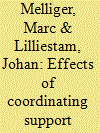

|
|
|
|
|
| Summary/Abstract |
The economic context for renewable power in Europe is shifting: feed-in tariffs are replaced by auctioned premiums as the main support schemes. As renewables approach competitiveness, political pressure mounts to phase out support, whereas some other actors perceive a need for continued fixed-price support. We investigate how the phase-out of support or the reintroduction of feed-in tariffs would affect investors’ choices for renewables through a conjoint analysis. In particular, we analyse the impact of coordination – the simultaneousness – of policy changes across countries and technologies. We find that investment choices are not strongly affected if policy changes are coordinated and returns unaffected. However, if policy changes are uncoordinated, investments shift to still supported – less mature and costlier – technologies or countries where support remains or is reintroduced. This shift is particularly strong for large investors and could potentially skew the European power mix towards an over-reliance on a single, less mature technology or specific generation region, resulting in a more expensive power system. If European countries want to change their renewable power support policies, and especially if they phase out support and expose renewables to market competition, it is important that they coordinate their actions.
|
|
|
|
|
|
|
|
|
|
|
|
|
|
|
|
| 6 |
ID:
179667


|
|
|
|
|
| Summary/Abstract |
The European Union has decided to replace its previously existing A+++ to D labelling scheme for cold appliances with a rescaled A to G labelling scheme in 2021. Employing a demographically representative discrete choice experiment on refrigerator adoption using an online survey among more than 1000 households in Germany, this paper explores the effects of the rescaled scheme compared to the previous scheme on the stated uptake of top-rated refrigerators, i.e. those classified A+++ under the previous scheme and B under the rescaled scheme. Since in practice both schemes may be shown for a transitory period, the paper also explores the effects of displaying both labels simultaneously. The findings from estimating a mixed logit model suggest that showing the rescaled label alone significantly increases valuation of top-rated refrigerators compared to showing the previous A+++ to D label alone. In comparison, when the previous A+++ to D and the rescaled A to G schemes are shown simultaneously, no benefits of introducing the rescaled label are found. Thus, policymakers should strive to enforce the application of the rescaled labelling scheme as quickly as possible and to shorten transitory periods where both labels are shown simultaneously.
|
|
|
|
|
|
|
|
|
|
|
|
|
|
|
|
| 7 |
ID:
179735


|
|
|
|
|
| Summary/Abstract |
This study applied a discrete choice experiment using best-worst scaling questions (multi-profile, BWS case 3) to estimate the trade-offs which a sample of the Polish population is willing to make for energy reform regarding carbon reduction. Attributes considered in the study are CO2 emissions reduction, National energy independence, Employment impact, Time needed for policy transition, and Impact on household energy prices. Respondents (n = 639) choose the best and worst of the presented policy options to fit a rank-ordered logit model. This study reveals concern about climate change among respondents, but that they prioritize energy prices and employment in their choice of preferred energy policy with significant variation across groups. A key distinction is revealed in the preferences by age cohort in which youngest (<25years old) respondents had the strongest WTP coefficients, particularly for CO2 and time to transition. Stronger and more urgent desires for CO2 reduction policies were also identified among the decisions of female respondents, those having more education, those without children, and middle and upper income groups. The respondents’ choices also revealed consistent loss aversion in all attributes presented in the choice experiment.
|
|
|
|
|
|
|
|
|
|
|
|
|
|
|
|
| 8 |
ID:
150675


|
|
|
|
|
| Summary/Abstract |
The importance of renewable energy as a response to climate change is universally acknowledged. However, its successful implementation requires public approval and cooperation. This study aims to identify the level of renewable energy acceptance in Korea by estimating Korean consumers’ additional willingness to pay (WTP) using the contingent valuation (CV) method, which is the most widely used to analyze consumer preferences. The estimation results indicate that Korean consumers are willing to pay an additional USD 3.21 per month for electricity generated with renewable energy. However, WTP in Korea is low relative to other advanced nations, indicating that these values could be influenced through policies aimed at improving knowledge and acceptance of renewable energy sources among Korean consumers.
|
|
|
|
|
|
|
|
|
|
|
|
|
|
|
|
| 9 |
ID:
133142


|
|
|
|
|
| Publication |
2014.
|
| Summary/Abstract |
In this paper, we identify key drivers and barriers for the adoption of building energy retrofits in Germany, which is promoted by public policy as an important measure to address the future challenges of climate change and energy security. We analyze data from a 2009 survey of more than 400 owner-occupiers of single-family detached, semidetached, and row houses in Germany, that was conducted as a computer-assisted personal interview (CAPI). In the survey, respondents were asked directly for reasons for and against retrofitting their homes, but also faced a choice experiment involving different energy retrofit measures. Overall, we find that house owners who are able to afford it financially, for whom it is profitable, and for whom there is a favorable opportunity are more likely to undertake energy retrofit activities. The latter point seems to be of particular importance in explaining the persistent low retrofit rate in Germany. Our results suggest that professional energy advice could stimulate the demand for building energy retrofits.
|
|
|
|
|
|
|
|
|
|
|
|
|
|
|
|
| 10 |
ID:
177142


|
|
|
|
|
| Summary/Abstract |
Increasing concerns about the water-related impacts posed by shale gas development have prompted the need for protecting water resources. Determining the preferences for shale water management is critical for the design and implementation of cost-effective management strategies. Nevertheless, the public's multidimensional preferences for different aspects of the shale water management have not yet been addressed in shale-related studies. To this end, a choice experiment is used to examine the preference heterogeneity for shale water management that would improve water consumption, wastewater recycling, and water quality monitoring in Fuling shale gas field, southwest China. Results from a random parameter logit model show that residents' average WTP is 45.76 yuan per year per household for the improvements of all water-related attributes to the highest qualitative level. The accumulated welfare gains indicate that local government could increase the gas price by 0.058 yuan per cubic meter for implementing water management strategies. We also find considerable preference heterogeneity in both systematic and random utility components, and average WTP is significantly influenced by the respondent's demographical and psychological characteristics. The findings highlight the potential to find socially acceptable ways to promote shale water management and provide insight into the relevant policymaking process.
|
|
|
|
|
|
|
|
|
|
|
|
|
|
|
|
| 11 |
ID:
150738
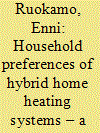

|
|
|
|
|
| Summary/Abstract |
The residential heating sector presents considerable energy savings potential, as numerous heating solutions for reducing electricity consumption and utilizing renewable energy sources are available in the market. The aim of this paper is to examine determinants of household heating system choices and to use this information for policy planning purposes. This paper investigates residential homeowner attitudes regarding innovative hybrid home heating systems (HHHS) with choice experiment. Heating system scenarios are designed to represent the most relevant primary and supplementary heating alternatives currently available in Finland. The choice sets include six main heating alternatives (district heat, solid wood, wood pellet, electric storage heating, ground heat pump and exhaust air heat pump) that are described by five attributes (supplementary heating systems, investment costs, operating costs, comfort of use and environmental friendliness). The results imply that HHHSs generally appear to be accepted among households; however, several factors affect perceptions of these technologies. The results reveal differing household attitudes toward the main heating alternatives and show that such views are affected by socio-demographic characteristics (age, living environment, education, etc.). The results suggest that households view supplementary heating systems (especially solar-based) favorably. The other attributes studied also play a significant role in decision making.
|
|
|
|
|
|
|
|
|
|
|
|
|
|
|
|
| 12 |
ID:
177354


|
|
|
|
|
| Summary/Abstract |
The study investigates the preferences for Demand Side Management programs for electricity usage in Poland. Using stated preference data generated from a choice experiment with a large representative sample of the Polish population, we estimate willingness to accept changes in electricity consumption. We also explore the impact of social comparison of households’ energy use on the acceptance of Demand Side Management as a potential driver of preference heterogeneity with respect to electricity services.
|
|
|
|
|
|
|
|
|
|
|
|
|
|
|
|
| 13 |
ID:
113422


|
|
|
|
|
| Publication |
2012.
|
| Summary/Abstract |
New Zealand homes are poorly insulated by international standards. There are government subsidies available for people to improve the energy efficiency of their homes but uptake has been relatively low among owners of rental properties. This paper presents the results of a choice experiment used to investigate the preferences of home owners and tenants for insulation and heating upgrades. The responses indicate that landlords may underestimate how cold their rental properties are in winter, considering the level of discomfort reported by tenants. Median willingness-to-pay (WTP) for improved insulation by landlords is only 50-70% of owner-occupier values. Landlords are willing to pay more for a heating appliance than any other retrofit option. In contrast, tenants have a low WTP for the heating appliance and would prefer under-floor insulation. Tenants express a willingness to pay higher rent in exchange for improved energy efficiency, at a rate that would appear to make such upgrades economic for the landlord. Information asymmetry and lack of appropriate market signals may be a large part of the reason why many landlords are not willing to pay market prices for energy efficiency upgrades.
|
|
|
|
|
|
|
|
|
|
|
|
|
|
|
|
| 14 |
ID:
149980


|
|
|
|
|
| Summary/Abstract |
Asymmetric information may explain low energy efficiency in rented properties. Energy ratings, while a solution to the information problem, will only lead to higher efficiency levels if renter's willingness-to-pay (WTP) exceeds landlord's investment costs. Using a sample of renters from one university, this paper estimates this WTP using a discrete choice experiment where respondents choose from a hypothetical set of single-bedroom apartments that differ according to a number of attributes including the energy rating. Results show that there is a strong disutility associated with the least efficient properties and that renters will pay significantly more for efficiency improvements at the lower end of the efficiency scale. Importantly, our WTP estimates are calculated in a setting where respondents were informed about the energy rating system prior to choosing and where the rating was shown for every property. Therefore, in order to maximise the impact of energy rating systems, policymakers are encouraged to ensure that both these informational characteristics are in place.
|
|
|
|
|
|
|
|
|
|
|
|
|
|
|
|
| 15 |
ID:
092731
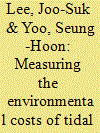

|
|
|
|
|
| Publication |
2009.
|
| Summary/Abstract |
Korea is considering the construction of a tidal power plant (TPP) at Garolim Bay. However, as the construction of the Garolim TPP (GTPP) is expected to entail some environmental damage, it has become an increasingly important topic for public debate. Using a choice experiment (CE) approach, this study attempts to measure the economic cost that results from the environmental damage caused by the construction of GTPP. The CE is used to measure the environmental costs of individual attributes, including the reduction in the area of the tidal flat, the degradation of seawater quality, and the destruction of marine life. The results indicate that the annual willingness to pay (WTP) per household for mitigating the environmental damage that results from the worst-possible situation in relation to the present situation is about 96,042 Korean won (USD 101.1) in the seven biggest cities (off-site regions) and 18,584 Korean won (USD 19.6) in Seosan and Taean (on-site regions). This study is expected to provide policy-makers with quantitative information that will be useful to decide whether or not GTPP should be constructed.
|
|
|
|
|
|
|
|
|
|
|
|
|
|
|
|
| 16 |
ID:
192775


|
|
|
|
|
| Summary/Abstract |
While heat pumps are a promising solution for decarbonizing residential buildings, financial barriers often hinder their diffusion. Asset leasing – whereby service providers lease equipment and provide services in exchange for monthly payments – could help overcome some of the barriers to adoption. This study investigates homeowners' preferences for heat-pump leasing, examines their inclination to lease or purchase, and quantifies their willingness to pay for different services. Empirical insights are drawn from a discrete choice experiment conducted with 915 single-family house owners who undertook 9150 hypothetical leasing decisions in France, Germany, and Switzerland. Survey results show an interest in flexible, all-inclusive leasing offerings, especially in markets where heat pumps are at an early stage of diffusion. However, preferences for asset leasing differ between countries. German house owners are the most open to leasing and would on average be willing to pay up to three times more than their French counterparts to shield themselves against technical risk. Given the role asset leasing could play in decarbonizing residential heat and enhancing energy security, policy makers may wish to adapt policy incentives to account for these service-based offerings.
|
|
|
|
|
|
|
|
|
|
|
|
|
|
|
|
| 17 |
ID:
168321


|
|
|
|
|
| Summary/Abstract |
Energy transition towards a sustainable system comprising various energy sources is a major challenge. We conducted a representative survey in the German-speaking part of Switzerland to elicit the population's preferences for electricity from solar, wind or natural gas under different institutional and site-specific conditions. Based on a choice experiment we found a consistent preference for electricity based on solar energy and - to a lesser degree - wind energy, built in existing industrial and commercial areas. We identified five distinct population groups, three of which have a very pronounced profile concerning energy attributes: ‘Pro Renewables', ‘Pro Switzerland’, and ‘Pro Landscape’. The largest two groups, 'Moderates' and ‘Contra Status Quo’ value attributes fairly equally. All groups except Pro Landscape prefer electricity from Switzerland, and all groups except Pro Switzerland accept imports of renewable electricity, preferably from plants operated by Swiss firms. We suggest that unfamiliarity rather than nationalism is at the root of opposition to imports of renewables. An energy mix focusing on renewables and including border-crossing electricity infrastructure could pave the way for a cost-efficient energy transition towards a sustainable and resilient electricity system. Our results show that it would also be publicly acceptable by the majority of the Swiss population.
|
|
|
|
|
|
|
|
|
|
|
|
|
|
|
|
| 18 |
ID:
096146


|
|
|
|
|
| Publication |
2010.
|
| Summary/Abstract |
This paper uses a random utility model to estimate consumers' valuation of energy efficient insulation and ventilation systems in rental apartments. Given consumers' limited experience in residential buildings and the perceived uncertainty about their comfort benefits and resulting energy savings, these relatively new technologies might be undervalued by risk-averse consumers. Using the concept of certainty-equivalence, this paper proposes a model to assess the consumers' risk-aversion for adopting energy-efficient systems. These systems are treated as risky assets while conventional commodities are assumed to be risk-free. The curvature of the utility function is interpreted as a measure of aversion to perceived risks as opposed to explicit risks measured by observed variances. The proposed formulation is applicable in stated preference data with qualitative variables. The model is applied to data from a choice experiment conducted among 264 apartment tenants in Switzerland. The estimated curvatures reject the risk-neutrality hypothesis. The range of the estimated risk premiums suggests that risk considerations remain a central issue in dealing with energy efficiency in residential buildings. The analysis also indicates that assuming same risk attitudes toward new and conventional systems could bias the estimates of the willingness to pay, especially when the system is comprised of several components.
|
|
|
|
|
|
|
|
|
|
|
|
|
|
|
|
| 19 |
ID:
125696


|
|
|
|
|
| Publication |
2013.
|
| Summary/Abstract |
The study reports data from an economic choice experiment to determine the likely welfare impacts of hydraulic fracturing, in this case using natural gas extracted by hydraulic fracturing for household electricity. Data were collected from an Internet survey of 515 residents of New York State. The welfare analysis indicated that on average households incur a welfare loss from in-state hydraulic fracturing as the source of their electricity. The evidence suggests that households in shale counties bear more costs from HF electricity than households out of shale counties. The average welfare loss is substantive, estimated at 40-46% of average household electric bills in shale counties and 16-20% of bills in counties without shale. The evidence also suggests that relative proximity to HF well sites also increases cost borne by households.
|
|
|
|
|
|
|
|
|
|
|
|
|
|
|
|
| 20 |
ID:
128356
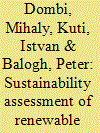

|
|
|
|
|
| Publication |
2014.
|
| Summary/Abstract |
Rationalisation of consumption, more efficient energy usage and a new energy structure are needed to be achieved in order to shift the structure of energy system towards sustainability. The required energy system is among others characterised by intensive utilisation of renewable energy sources (RES). RES technologies have their own advantages and disadvantages. Nevertheless, for the strategic planning there is a great demand for the comparison of RES technologies. Furthermore, there are additional functions of RES utilisation expected beyond climate change mitigation, e.g. increment of employment, economic growth and rural development. The aim of the study was to reveal the most beneficial RES technologies with special respect to sustainability. Ten technologies of power generation and seven technologies of heat supply were examined in a multi-criteria sustainability assessment frame of seven attributes which were evaluated based on a choice experiment (CE) survey. According to experts the most important characteristics of RES utilisation technologies are land demand and social impacts i.e. increase in employment and local income generation. Concentrated solar power (CSP), hydropower and geothermal power plants are favourable technologies for power generation, while geothermal district heating, pellet-based non-grid heating and solar thermal heating can offer significant advantages in case of heat supply.
|
|
|
|
|
|
|
|
|
|
|
|
|
|
|
|
|
|
|
|
|